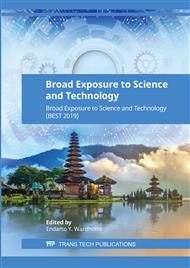[1]
Alfirano, S. Mineta, S. Namba, T. Yoneda, K. Ueda, T. Narushima, Precipitates in as-cast and heat-treated ASTM F75 Co-Cr-Mo-C alloys containing Si and/or Mn, Metall. Mater.Trans. A 42 (2011) 1941-1949.
DOI: 10.1007/s11661-011-0604-4
Google Scholar
[2]
Alfirano, S. Mineta, S. Namba, T. Yoneda, K. Ueda, T. Narushima, Heat treatment of ASTM F75 Co-Cr-Mo-C-Si-Mn alloys, Mater. Sci. For 654 (2010) 2180-2183.
DOI: 10.4028/www.scientific.net/msf.654-656.2180
Google Scholar
[3]
J.V. Giacchi, C.N. Morando, O. Fornaro, H.A. Palacio, Microstructural characterization of as-cast biocompatible Co-Cr-Mo alloys, Mater. Charact. 62 (2011) 53-61.
DOI: 10.1016/j.matchar.2010.10.011
Google Scholar
[4]
S Mineta, Alfirano, S Namba, T Yoneda, K Ueda, T Narushima, Phase and morphology of carbides in ASTM F75 Co-Cr-Mo-C alloys formed at 1473 to 1623 K, Mater. Sci. For 654 (2010) 2176-2179.
DOI: 10.4028/www.scientific.net/msf.654-656.2176
Google Scholar
[5]
S. Mineta, Alfirano, S. Namba, T. Yoneda, K. Ueda, T. Narushima, Phase and Formation/ dissolution of precipitates in biomedical Co-Cr-Mo alloys with nitrogen addition, Metall. Mater.Trans. A 44 (2013) 494-503.
DOI: 10.1007/s11661-012-1399-7
Google Scholar
[6]
K. Sugawara, Alfirano, S. Mineta, K Ueda, T. Narushima, Formation of the χ-phase precipitate in Co-28Cr-6Mo alloys with additional Si and C, Metall. Mater.Trans. A 46 (2015) 4342-4350.
DOI: 10.1007/s11661-015-3008-z
Google Scholar
[7]
K. Ueki, Y. Kurihara, S. Mineta, T. Yoneda, T. Narushima, Changes in microstructure of biomedical Co-Cr-Mo alloys during aging at 973 to 1373 K, Mater. Trans. 57 (2016) 2048-2053.
DOI: 10.2320/matertrans.mi201507
Google Scholar
[8]
T. Narushima, S. Mineta, Alfirano, K. Ueda, p-phase and c-phase: New precipitates in biomedical Co-Cr-Mo alloys, in: K. Sasaki (Ed), Interface Oral Health Science 2011, Springerlink, Berlin, 2012, pp.72-80.
DOI: 10.1007/978-4-431-54070-0_12
Google Scholar
[9]
Alfirano, S. Mineta, S. Namba, T. Yoneda, K. Ueda, T. Narushima, Precipitates in biomedical Co-Cr-Mo-C-N-Si-Mn alloys, Metall. Mater.Trans. A 43 (2012), 2125-2132.
DOI: 10.1007/s11661-011-1009-0
Google Scholar
[10]
A.L. Marco, Hernandez-Rodriguez, D.A. Laverde-Cataño, D. Lozano, G. Martinez-Cazares, Y. Bedolla-Gil, Influence of boron addition on the microstructure and the corrosion resistance of CoCrMo alloy, Metals 307 (2019) 1-11.
DOI: 10.3390/met9030307
Google Scholar
[11]
S. Lee, N. Nomura, A. Chiba, Effect of Fe addition on microstructures and mechanical properties of Ni- and C-Free Co-Cr-Mo alloys, Mater. Trans., 48 (2007) 2207–2211.
DOI: 10.2320/matertrans.mra2007004
Google Scholar
[12]
Z. de la Garza, M. Herrera-Trejo, M.R. Castro, E.V. Ramírez, M.N. Méndez, J.N. Méndez, Effect of Zr additions on mechanical properties of an ASTM F-75 alloy, J. Mater. Eng. Perform. 10 (2001) 153-156.
DOI: 10.1361/105994901770345150
Google Scholar
[13]
S.H. Lee, N. Nomura, A. Chiba, Significant improvement in mechanical properties of biomedical Co-Cr-Mo alloys with combination of N addition and Cr-enrichment, Mater. Trans., 49 (2008), 260-264.
DOI: 10.2320/matertrans.mra2007220
Google Scholar
[14]
T. Narushima, S. Mineta, Y. Kurihara, K. Ueda, Precipitates in biomedical Co-Cr alloys, JOM, 65 (2013) 9-16.
DOI: 10.1007/s11837-013-0567-6
Google Scholar
[15]
J. Escobedo, J. Mendez, D. Cortes, J. Gomez, M. Mendez, H. Mancha, Effect of nitrogen on the microstructure and mechanical properties of a Co-Cr-Mo alloy, Mater. Des. 17 (1996) 79-83.
DOI: 10.1016/s0261-3069(96)00036-2
Google Scholar
[16]
K. Yamanaka, M. Mori, A. Chiba, Effects of carbon addition on mechanical properties and microstructures of Ni-Free Co–Cr–W-based dental alloys, in: K. Sasaki, O. Suzuki, N. Takahashi (Eds). Interface Oral Health Science 2014, Springer Open, Sendai, 2014, pp.225-236.
DOI: 10.1007/978-4-431-55192-8_19
Google Scholar
[17]
S.H. Lee, E. Takahashi, N. Nomura, A. Chiba, Effect of carbon addition on microstructure and mechanical properties of a wrought Co–Cr–Mo implant alloy, Mater. Trans. 47 (2006) 287-290.
DOI: 10.2320/matertrans.47.287
Google Scholar


